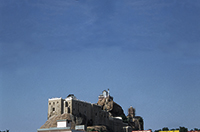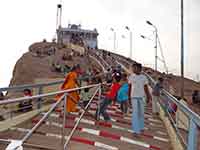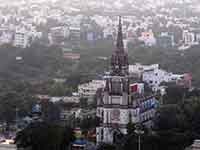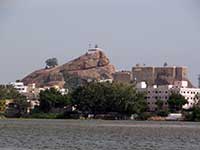Tiruchirappalli Tourist Places Or Places to Visit in Tiruchirappalli
Thiruchirappalli derived its name due to Jain association with this place. Buddhism and Jainism thrived in Tamil Nadu before the renaissance of Hinduism in the form of the Bhakti cult which popularized Saivism and Vaishnavism and exterminated these anti-Hindu Religions. So, we find numerous Jain and Buddhist traces scattered in remote and unapproachable spots throughout Tamil Nadu. 'Chira' is actually the name of a Jain monk and once in this rock was his 'palli' (abode). Therefore, it came to be known as Chirappalli and Thiru was added to it as it is an adjective of reverence in the Tamil language. Now nobody takes pain to pronounce its full name nd reduced the beautiful name to 'Trichy' properly pronounced as 'Trichy'-these popular shortening of place names is a peculiar character of the Tamils, e.g. Kovai for Coimbatore, Mayilai for Mylapore, Tharaifor Dharapuram, Thanjai for Thanjavur etc. There is a special rule in the Tamil grammer for shortening names like this it is called "Maruvu".
Tiruchirappalli City
Tiruchirappalli, or “the City of the Three-Headed Demon,” sprawls at the foot of colossal Rock Fort, where the Vijayanagar empire built its once-impregnable citadel when they wrested power from the Cholas in the 10th century. The Vijayanagars and their successors, the Nayaks of Madurai, started work on one of South India’s largest and most impressive temple towns, Srirangam, on an island created by the Cauvery and one of its tributaries, just beyond Tiruchirappalli. During the bitter Carnatic wars, French and British forces battled for control of the city, both keen to establish control of the looming hilltop fortress. Today a number of neo-Gothic Christian monuments remain as evidence of the British influence during the 18th and 19th centuries, when a Cantonment was established here and when much of the present-day city was built. Almost directly east of Tiruchirappalli (or Trichy, as it’s thankfully known), Thanjavur (also known as Tanjore) was the capital of the Chola empire—which included present-day Kerala, Sri Lanka, and parts of Indonesia. Its 11th-century Brihadeshvara Temple is a World Heritage monument and, together with Mamallapuram and Madurai, an important stop on Tamil Nadu’s temple route.
Even before its association with Jains, it was a famous place in the Sangam Age and the capital city of Cholas, called 'Uraiyur'. It has a prime place in the history of Tamil Nadu. The Cheras, the Cholas and the Pandyas, the later Cholas, the Vijayanagar rulers, the Marathas, the Nawabs, the French and finally the British all of them coveted to possess this strategic place which is more or less centrally located place in Tamil Nadu. This was the scene of the decisive Carnatic War which enabled the British to emerge as the future undisputed masters of the Indian sub-continent. It is at present the fourth major city of Tamil Nadu and the headquarters of Trichy district.
Tiruchirappalli India
Situated on the banks of the river Kaveri, it was a Chola fortification from the 2-century. The control went back and forth between the Pallavas and the Pandyas until the 10-century when the Cholas assumed power of this strategically important town once again. When the Chola Empire finally ended, Tiruchirapalli or Trichy came under the Vijayanagar rulers until their defeat in 1565 by the forces of the sultans of Decan. It came to prominence under the Nayaks of Madurai by the 16-century, who built its most famous landmark, the Rock Fort Temple. It was later ruled by the Marathas, the French, and the British and saw ravages of wars for over a century. The British and the French fought the historic Carnatic wars around the Trichy Fort, which finally decided the supremacy of the British over the Indian subcontinent.
Today Trichy is a major city of Tamil Nadu and besides being an industrial suburb,it hosts the locomotive workshop, an ordinance factory, and a regional engineering college. With a fine blend of temples and monuments, it is a popular tourist destination. Most of the hotels, restaurants, and other services required by the tourists are in the junction or cantonment area near the railway station.
Among the other religious sites in the town, near the Teppakolam, the 18-century St. John's Church is an interesting colonial structure. It has louvered side doors that can be opened to turn the church into an airy pavilion. The Lourdes Church, designed as a smaller version of the Basilica at Lourdesin France is the site of an annual procession held every year on 11 February. The Nathervali Dargah near the Teppakolam is the tomb of the popular Muslim saint. It is a marvelous piece of architecture with its 20m high white marble dome and metal steeple. In addition, worth a visit is the Govt. Museum, located on Bharathidasan Road in cantonment area. It exhibits bronze and stone sculpture, art and handicrafts.
Tiruchirappalli Sightseeing
Spend anywhere from a half- to a full day here, devoting the majority of your time to the atmospheric temple town of Srirangam. In the evening, climb the steps to the summit of Rock Fort in time to witness the sun setting over the city (entrance at China Bazaar; Rs 1/2¢, Rs 10/25¢ camera, Rs 50/$1.15 video camera; daily 6am–8pm). This is also the time you’re likely to encounter the greatest number of devotees coming to worship at the Shiva temple (off-limits to non-Hindus) and paying tribute to the elephant-headed god, Ganesh, at his summit shrine. Little of the old fortification has survived (though some inscriptions date back to the 3rd c. B.C.), but you may be interested to know that at 3,800 million years old, the rock itself is said to be one of the oldest on Earth, predating the Himalayan range by around a million years. Alongside Rock Fort is the huge Teppakulam Tank, and across from this, Our Lady of Lourdes Church, built in 1840.
Tiruchirappalli Temple
Tiruchirappalli Rock Fort
This is the important landmark of Trichy. It is an 83m (237ft) high rock that is the only outcrop in the otherwise flat land of the city. This is perhaps the oldest rock in the world as old as the rocks of Greenland. The Himalayas are infaint rocks compared to its age. There are fascinating temples with brilliant architecture in it: Thayumanavar temple, a Siva shrine in the middle and a Ganesa tempe at the top called 'Uchipillaiar Koil'. Two Pallava cave temples, one on the way to the Pillaiar Koil and th other I the northwest end of the street around the hill. A flight of steps leads to the Thayumanava Swami temple the presiding deity of which is a projection of the rock itself. There are on the whole 437 steps cut into a tunnel through the rock. There is a 100 pillared wall and a vimanam covered with gold in the Thayumanavaswami temple. The cave temple belongs to the Pallava period and Pallava king Mahendra Varman (6th century Ad) built this cave temple inside which is a beautiful carving of Gangadhara. The image must have been the first one fashioned by the Pallavas. From the Uchipillaiar Koil one can have a panoramic view of the city on all the four sides.
The winding river Cauvery and the temples of Srirangam and Thiruvanaikaval can be seen from the northern side. The view is spectacular and a fitting reward for painstaking ascend. The Teppakulam built by Viswanatha Nayak is another landmark. This tank with the background of the fort is very imposing. Teppakulam is the float festival tank. Very little remains of this fort built in 1660. It played an important part during the Carnatic wars and according to an inscription, mainly contributed to lay the foundation of the British Empire in India.
On the top of the rock is the Ucchi Pillayarkoil, a temple dedicated to Lord Vinayaka (Ganesha). It is a stiff climb to the summit up the 437 rock cut steps. From here, you get marvelous views of Trichy. On your way up there are remains of a thousand pillared hall. Further up is a hundred pillar hall. At the end of the last flight is the Thayumanaswami Temple, dedicated to Lord Shiva, which has a golden vimana and a lingam, which is a projection of the rick itself. There are two 7-century Pallava cave temples, below the Shiva Temple, which have beautifully carved pillars and panels. At the foot of the rock is Teppakolam, a large artificial tank. The temple deities taken out on rafts during the Festival of Floats on Teppakolam in March attract devotees from all over 0431-2704621.
Trichy Srirangam Sri Ranganathaswamy Temple
The Sri Ranganathaswamy Temple complex at Srirangam is one of the largest in India. Srirangam is an island town, about 7km from Trichy, flanked by the river Kavari on one side and its tributary Kollidam (Coleroon) on the other. Spread over an area of 60 heacters with its 7 concentric walled sections and 21 gopurams, the temple is dedicated to Vishnu.
'Rangam' means island and Srirangam is the island between Cauvery and Kollidam (Coleroon) where Sri Ranganatha is lying on His Adi Sesha (snake) couch. The main sanctum of Sri Ranganatha is surrounded by 7 large enclosures and 21 majestic gopurams. On the south is Ranga Vilasam and Seshagiri Royal Mandapam with marvelous sculptural splendor. The main deity is enshrined within the first Corridor. The vimanam shaped like Omkara is plated with gold. The temple was constructed by the Chola king Dharmavarman and even before that, it is said that the temple existed buried under the sand. Almost all the kings who held sway in Tamil Nadu have spent lavishly to embellish the temple and even the British King Edward VII has presented a gold plate. Saint Ramanuja, the author of Vishistad-vaitham tenet functioned from here to spread Vaishnavism and His mortal remains are entombed in a sanctum here.
The unfinished tower started by Krishna Devaraya has now been completed (1987). It is the tallest in India rising 73m high with 13 tiers. The other gopurams were built between the 14th and 17th centuries by various kings.
The artistically splendor of this temple excels beyond description. The east-facing Krishna shrine is a display of feminine grace in stone. The Seshagiri Rayar Mandapam opposite the 1000 pillared mandapam is unique with its equestrian statues. The tiger hunt sculpture is a marvel in stone. The hall is a living testimony to the dexterity of the Vijayanagar craftsmen. The Amirta Kalasa Garuda is a superb carving in the vehicle mandapam. The eight-armed Venugopala and Lakshminarayana on Garuda are inimitable.
The 21-day festival of Vaikunta Ekadashi in December/January draws thousands of pilgrims. Another important festival here is the Temple Car Festival in January when statues of the deities are taken aboard a chariot in a magnificent procession. Vaikunda Ekadasi festival is very famous in this temple. At that time, the Paramapad Vasal (Paradise Gate) is opened and lakhs of pilgrims rush to enter it as it is believed that one who enters her will reach Vaikunta after death.
Thiruvanaikkaval
This Siva temple too is in the same island on the other side of the railway line. This is one of the Pacha Bootha Sthalam (five elements) and it is called Appu (water) Lingam. The element represented here is water. The deity is in water. A perennial subterranean spring gushes around the lingam. A peculiar practice observed in this temple is what while performing the midday puja the priest wears a woman's dress. Another peculiarity is the presence of Eka-Pada-Tirumurthi in which the trinity Siva, Vishnu and Brahma are combined in one. It is not found in any other temple in Tamil Nadu except in Thiruvottriyur near Chennai.
The temple has five enclosures and the walls reach a height of 35ft. Numerous sculptures of rare beauty could be found everywhere in the temple. The figure of a nomadic gypsy with her palm-leaves woven basket holds the onlooker spellbound. It is near sanctum of Sri Sankara.
The nearby Jambukeswara Temple 2km east of Srirangam at Tiruvanaikkaval is dedicated to Shiva and has five concentric walls and seven gopurams. Being one of the five Shiva temples honoring the five elements (the element represented here is water), the temple is built around a lingam partly submerged in water that comes from a spring within the sanctum sanctorum. It was built around the same time as the Sri Ranganathaswamy Temple. Numerous beautiful sculptures can be found everywhere in this temple. There are interesting festivals in January and at the time to spring. The architectural fineness of this temple gives an idea of the Dravidian temple style at its best.
Samayapuram Mari Amman Koil
Samayapuram Mari Amman Koil is a very famous temple near Thiruvannaikkaval. The grace of Mari Amman here has turned an illiterate fool into a poet. This temple attracts thousands of devotees every day.
Vayalur
Vayalur is 8km from trichy and a famous Murugan temple is seen here amidst bushy green fields. The gopuram of this temple was built by the famous devote of Lord Muruga, Sri Kripananda Variar. It is a famous temple devoted to Lord Muruga at Vayaloor has an impressive gopuram. Located in the midst of lush green vegetation, it is a fine picnic spot.
Mukkombu
Mukkombu is very beautiful picnic spot about 18km from Trichy. Green carpeted fields fill the route. Here the river Cauvery branches off into Kollidam (Coleroon). There is a well laid-out park. There is a barrage called Upper Anaicut. A beautiful spot of picturesque scenery.
Thiru Erumbur
Thiru Erumbur is about 10km from Trichy is the famous place where an ant (erumbu) worshipped Lord Siva and got bliss. The temple has 3 prakaras or enclosures, one down the hill and the other two up th hill. The temple belongs to the Chola period. There is a beautiful sculpture of Gangalamurthi here not to be missed by any lover of art.
Thiruvellarai
Thiruvellarai is about 15km from Trichy is Thiruvellarai, famous for its Pallava cave temple and a strange swastika well belonging to the period of Dantivarman.
Pullamangai
This place near Trichy is famous for an early Chola temple built by Parantaka Iknown for its sculptural splendor. The presiding deity of PUllamangai is Brahmapuriswara. One can see how the Chola sculpture gave life to stone as even the ganas or demons that worship Siva are carved with minute details expressive faces, pot-bellied in fantastic poses. They embellish the roof of the Ardha Mandapam. Brahma, Lingodhbhava, Dacing Siva, Eight Armed Durga are the other entrancing sculptures here.
Elakurichi
At Elakurichi nearby is the famous church built by the well known catholic missionary. Constantine Joseph Beschi, popularly known as Veeramamunivar. He has done yeoman service to Tamil and even the first modern Tamil dictionary called 'Chathur Agarathi' was compiled by him.
Besides, there are several other churches, colleges and missions dating back to 1760's As excellent infrastructural facilities are available in Trichy, it can be convenient place to see east-central Tamil Nadu.
Sri Pundareekasha Perumal Temple
Sri Pundareekasha Perumal Temple is about 20km north of Trichy on the Turaiyur Road, Tiruvellarai has the ancient Sri Pundareekasha Perumal Temple atop a rocky hill with a swastika shaped water tank. This temple is one among the 108 divya desams and has the pride of Mangalasanam, made to the shrine by Azhwars.
Uthamarkoil
Uthamarkoil is about 12km in Karumbanur is the Uthamarkoil, where one can worship Lord Brahma, Lord Vishnu and the Lord Shiva in the same complex. Located between Tiruchirapalli-Musiri Road, Gunaseelam (24km) has a temple dedicated to Lord Prasanna Venkateshwarar.
Viralimalai
The central route from Trichy to Madurai goes to Viralimalai on the main Dindigul Road. 30km south of Trichy on the Madurai Road, Viralimalai has on the 15-century temple dedicated to Lord Muruga on the hillock. The presiding deity is seated on a peacock mount with his two consorts, Valli and Deviyani. There is also a peacock sanctuary.
Kodumbalur
Kodumbalur is about 5km to the south of Viralimalai is Kodumbalur. 42km from Trichy or 36km from Pudukottai, also known as Moovarkoil it was formerly the seat of the Irukuvelar, an illustrious warrior clan seeking descendants from the Cholas. Of the three shrines built by Boodhi Vikaramakesari a General in the army of Chola in the 10th century, only two exist now. The sculptures of Kalarimurthi, Gajasamharamurthi, Ardhanareeswarar, Gajasamharamurthi etc. are masterpieces of art and the unique architecture of these temples is noteworthy. This place was also a stage of fierce battles between the Pandyas and the Pallavas. Nearby is the Muchukundeswarar Temple of the early Chola period.
Grand Anicut Barrage (Kallanai)
About 25km from Trichy, the original structure was built in the 2-century by the Chola King Karikalan and was reinforced by the successive rulers, to harness the waters of the Kaveri. The 320m long and 20m wide dam made of stone is a good picnic spot.
Other scenic and picnic sports around Tiruchirapalli include Mokkombu (18km) on road to Karur; Puliancholai (72km) at the foot of Kolli Hillis also has waterfalls known as Dakshina Ganga; Pachamalai (80km) near Turiaiyur has tribal settlements and is famous with foreign tourists and the Ponnaiyar Dam (70km) in the Idayapatti village in Karur district having lush green meadows and trees in between Semmamalai and Perumal Malai hills.
How to Reach Thiruchirappalli?
Trichy is very well connected by a good network of roads to all the important places in Tamilnadu. Umpteen bus services with high frequencies ply buses to all major places in Tamilnadu. Town buses ply to the nearby places of tourist importance. It is also a major junction I Southern Railway and is linked to Chennai, Madurai, Thanjavur, Bangalore, Mysore, Tirupathi, Rameswaram, Thiruvananthapuram and Kochi. The Trichy airport has flights to Chennai, Sharjah, Kuwait and Colombo.
Distance from Thiruchirappalli To Other important places Or |
||
|---|---|---|
| City | Distance | |
| Coimbatore | 203 Km | |
| Cuddalore | 173 Km | |
| Dharmapuri | 207 Km | |
| Dindigul | 70 Km | |
| Ernakulam | 379 Km | |
| Erode | 143 Km | |
| Hogenakkal | 252 Km | |
| Hosur | 303 Km | |
| Kanchipuram | 270 Km | |
| Kanyakumari | 370 Km | |
| Karaikudi | 160 Km | |
| Karur | 77 Km | |
| Kodaikanal | 90 Km | |
| Kodikkarai | 189 Km | |
| Krishnagiri | 355 Km | |
| Kumbakonam | 94 Km | |
| Madurai | 128 Km | |
| Mamallapuram | 291 Km | |
| Mysore | 340 Km | |
| Nagappattinam | 134 Km | |
| Nagercoil | 389 Km | |
| Palani | 135 Km | |
| Pollachchi | 215 Km | |
| Puducherry | 198 Km | |
| Poompuhar | 163 Km | |
| Pudukkottai | 50 Km | |
| Rajapalayam | 213 Km | |
| Rameswaram | 228 Km | |
| Ranipettai | 272 Km | |
| Salem | 140 Km | |
| Tenkasi | 287 Km | |
| Thanjavur | 55 Km | |
| Thekkadi | 213 Km | |
| Tiruchchendur | 342 Km | |
| Chennai | 319 Km | |
| Tirunelveli | 279 Km | |
| Tirupathi | 379 Km | |
| Tiruppur | 164 Km | |
| Tiruttani | 312 Km | |
| Tiruvannamalai | 216 Km | |
| Thrissur | 312 Km | |
| Tiruvananthapuram | 387 Km | |
| Tuticorin | 261 Km | |
| Udagamandalam | 301 Km | |
| Ulundurpet | 122 Km | |
| Valparai | 255 Km | |
| Vellore | 308 Km | |
| Yercaud | 169 Km | |
Thiruchirappalli Photo
 |
 |
 |
 |
